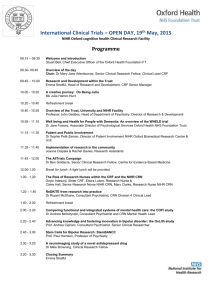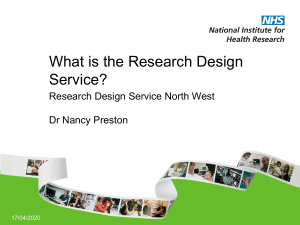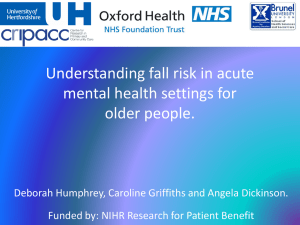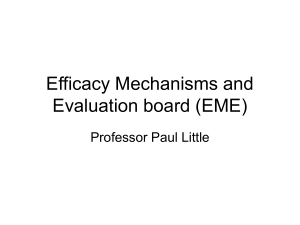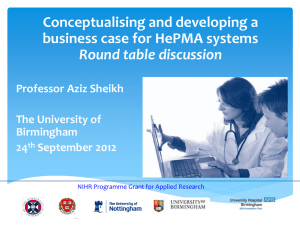95(ii)_BOD_RDBoardReport 7 14 - Oxford Health NHS Foundation
advertisement
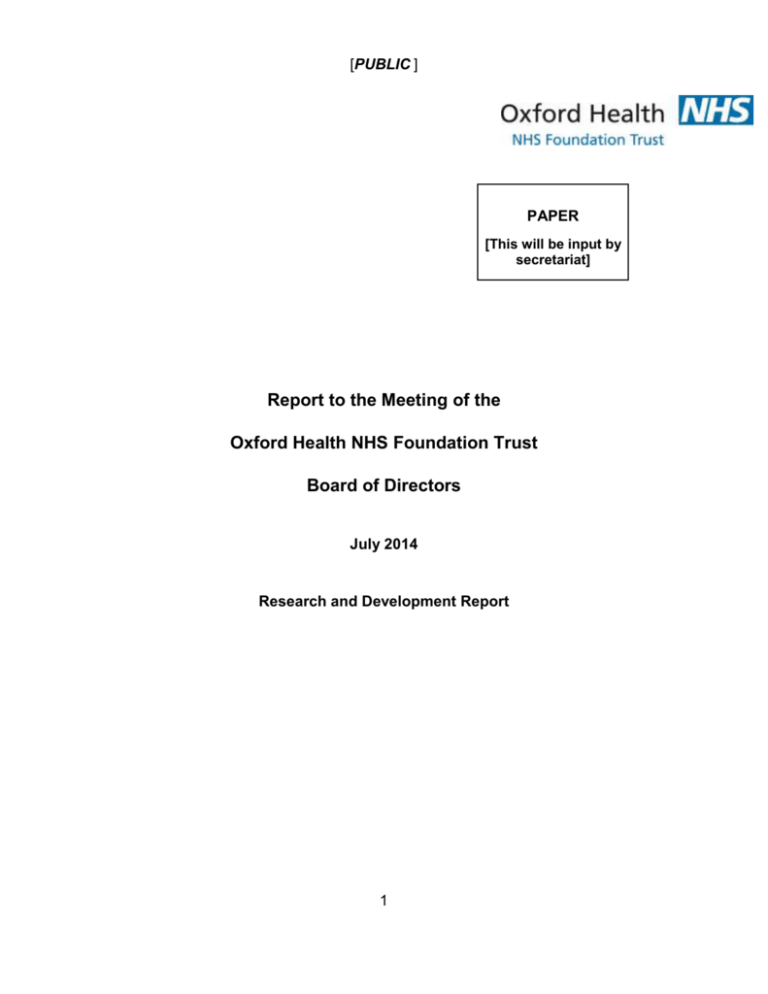
[PUBLIC ] PAPER [This will be input by secretariat] Report to the Meeting of the Oxford Health NHS Foundation Trust Board of Directors July 2014 Research and Development Report 1 [PUBLIC ] Clinical Quality and Care It is increasingly recognised that participation in research produces widespread benefits for patients and, more generally, improvements in quality of care. Research active clinical services are more likely both to generate and speed access to innovations in health care. The high levels of quality assurance required in research governance and ethical approval procedures can drive up the rigour and quality of routine clinical care. Research often requires cutting edge scientific infrastructure – for example brain imaging facilities - which can also be used for routine clinical care. There is also evidence that more academic clinical organisations are more successful in effectively recruiting and retaining high quality staff. Engagement in R&D activity can increase staff morale, help attract and protect resources and improve the status and profile of a healthcare provider. Networks and Collaborations The Trust continues to significantly engage in research activity, particularly within the area of mental health, where it is acknowledged we are in the top three nationally. The Trust is remodelling its clinical services, including physical and integrated healthcare services. In order to do this successfully, effective involvement in networks and collaborations is key. There have been a number of major academically based NHS initiatives aimed at increasing research productivity and accelerating the adoption and diffusion of innovation into clinical practice including: The creation of Academic Health Sciences Networks (AHSN), which followed the publication of Innovation Health and Wealth. The Trust is closely involved in the evolving Oxford AHSN which has brought a range of new opportunities. We have been particularly active in driving forward a number of the new Clinical Networks (see below). The creation of Collaboration for Leadership in Applied Health Research and Care (CLAHRC) centres. The Trust is the lead Trust for an Oxford CLAHRC (see below). The creation of four Diagnostic Evidence Co-operatives (DEC) to improve the way diseases are diagnosed. The Trust has been awarded one of the four. The Oxford Academic Health Sciences Centre (AHSC). The Trust is a key partner (with Oxford University Hospitals Trust; Oxford University & Oxford Brookes University). National Institute for Health Research (NIHR) Networks The NIHR infrastructure in England changed on the 1st April 2014. There were nine coordinating centres and 102 local networks across England, which encompassed 25 Comprehensive Local Research Networks in addition to various topic specific networks for 2 [PUBLIC ] cancer; medicines for children; stroke; diabetes; primary care; dementias; and neurodegenerative diseases and mental health. There was inconsistent coverage across the country, with complex geographies. There is now one coordinating centre and 15 local networks, with a simplified national coverage across all therapy areas. The networks are responsible for the distribution of £280 million of NIHR funding per year and have boundary alignment with the AHSN areas. They are considered the “research arm of the NHS” and are there to provide infrastructure needed to undertake clinical research; recognize and reward research as part of the “core business” of Trusts and its workforce; facilitate networks of research active clinicians; decrease or alleviate bureaucracy burden; and deal with systemic blocks to research delivery. The high level objectives include: doubling the number of participants recruited to portfolio studies; increased commercial trial activity, recruitment of patients to time and target; making the NHS the best place in the world to undertake clinical research; and to provide every patient the opportunity to take part in research. The Clinical Research Network (CRN) Thames Valley and South Midlands is within the Oxford AHSN area and is hosted by Oxford University Hospitals NHS Trust, with anticipated annual funding of £13 million. Each of the NIHR CRNs will now cover all therapy areas and allow flexible deployment of resources. Each CRN supports six divisions: Division 1: Cancer Division 2: Diabetes, stroke, cardiovascular disease, metabolic and endocrine disorders, renal disorders Division 3: Children, genetics, haematology, reproductive health and childbirth Division 4: Dementias and neurodegeneration, mental health, neurological disorders Division 5: Primary care, ageing, health services and delivery research, oral health and dentistry, public health, musculoskeletal disorders, dermatology Division 6: Anaesthesia/peri-operative medicine and pain management, critical care, injuries/emergencies, surgery, ears/nose/throat, infectious diseases/microbiology, ophthalmology, respiratory disorders, gastroenterology, hepatology. Research Governance Following a meeting in February 2014 of the newly reformed R&D committee it was decided that there should be two key R&D forums within the Trust. An R&D Governance Committee has therefore been established to address governance issues. Agenda items will consist of finance, staffing, current studies and recruitment, communications, CRIS, PPI and the reporting of sub group meetings (CRF Board, Finance, Study Review Panel, Monitoring and Auditing, CRF Users). The committee with meet quarterly, with representation including Director of R&D, Deputy Medical Director, Head of R&D, Clinical Lead for CRF, Research Governance Manager, Head of Information Governance, Deputy Director of Nursing, Head of 3 [PUBLIC ] R&D Finance, Contracts/legal lead, Primary Care Lead and Clinical Leads for Trust Divisions (being agreed). The minutes of meetings will go to the Clinical Effectiveness Committee (QuIC). The second new forum, the R&D Strategy Forum, will meet two to three times per year to discuss strategic R&D issues both within the organization and externally in collaboration with various other organisations. The R&D Strategy Forum membership is Director of R&D, Head of R&D, Clinical Lead for CRF and all members of the Trust Executive Board. Both of the new forums have already started meeting. Studies and Participant Recruitment The Trust currently hosts a number of different research studies, from small student projects to complex commercially sponsored CTIMPs. The table below shows current research activity ongoing within the Trust. The figures are transient due to projects starting and completing at different times. As at: of of Total, of Total Total of Total of Total, of Portfolio of Total Clinical of Total of Total of Total NIHR 26/06/2014 16:46 Number of OHFT PCT/OHFT Portfolio via CSP Students Psychology Funded PICs CTIMPs UKCRN studies sponsored new via CSP OHFT Trainees Portfolio Lead Open 112 23 27 12 75 15 11 3 68 62 21 Awaiting approval 13 2 3 0 5 1 2 0 7 7 0 Key: PIC – Participant identification centre CTIMP – Clinical Trial of Investigational Medicinal Product NIHR – National Institute for Health Research UKCRN – UK Clinical Research Network CSP – Coordinated System for gaining NHS Permission Since the last report there has been an increase in the number of studies ongoing within the organisation from 91 to 112. The average is transient and around 100 studies. The number of NIHR portfolio adopted studies has increased during the last six months from 59 to 68; the Trust is the lead site for 21 or these studies, a small decrease over the past six months. The number of participants (patients, carers, staff etc) recruited to studies ongoing within the Trust is shown in the table below: All OHFT Site Studies - Recruitment Portfolio Nonportfolio 2013/2014 2010/2011 2011/2012 2012/2013 1919* 2303 1822 2763 77** 53** 359 780 4 [PUBLIC ] Key: * because of previous years' inaccuracies this may be higher than actual ** incomplete return Although the recruitment to portfolio studies has increased over the last 12 months and Oxford Health NHS FT is the top recruiter nationally for mental health studies there needs to be consideration for succession planning as some of the studies currently on the portfolio recruit significant numbers and when complete could pose a risk to the figures as, at the moment, there are no large recruiting studies are in the pipeline. It is hoped that the new Research Implementation Manager will develop and implement a strategy to increase participant recruitment to all research studies throughout the Trust. The post will be supported by five research assistant posts situated within clinical teams throughout the Trust NIHR Metrics and Targets NHS organisations are expected to provide the NIHR with quarterly Performance Initiation and Delivery (PID) reports, detailing the number of studies that recruit the first participant into a clinical trial within 70 days of the organisation receiving a valid research application 1 and the number of studies recruiting the expected number of participants (time to target). These metrics may affect NIHR funding, with terms and conditions being incorporated into new contractual agreements for infrastructure and grant funding. Researchers are expected to inform the R&D department of the number of participants recruited to their study, in line with the NHS permission. This data will inform the PID reports that are compiled and published nationally every quarter. Consistent failure by Trusts to meet these targets may result in a reduction of up to 5% of Research Capability Funding to NHS organisations. The table below shows the number of studies initiating research (70 day benchmark) over the last 18 months. Performance in Initiating CTs Quarter NHS Permission granted within the period Number of studies with valid research application Number of studies that recruited 1st patient within 70 days Percentage of studies that recruited 1st patient within 70 days 3 – 2012/13 1 Jan 2012 to 31 Dec 2012 12 4 33% 4 – 2012/13 1 Apr 2012 to 31 Mar 2013 12 3 25% 1 – 2013/14 1 Jul 2012 to 30 Jun 2013 12 8 67% 1 A valid research application is a complete research application that has been received by the NHS organisation following its submission via the Integrated Research Application System (IRAS) that enables review by other agencies (including, but not limited to Research Ethics Committee and MHRA approval) to be conducted in parallel with the work on NHS permission by the contractor. For studies going through the NIHR Coordinated System for gaining NHS Permission (CSP) this will include a valid site specific information ford (SSI) and local associated documents as detailed on the IRAS checklist. Non CSP studies are also required to submit a valid application for both study wide and local reviews as detailed on the IRAS checklist. 5 [PUBLIC ] 2 – 2013/14 1 Oct 2012 to 30 Sept 2013 11 8 73% 3 – 2013/14 1 Jan 2013 to 31 Dec 2013 12 9 75% 4 – 2013/14 1 Apr 2013 to 31 Mar 2014 12 9 75% The table below shows the time to target for research studies over the last 18 months Performance in Delivering Commercial CTs Quarter NHS Permission granted within the period Number of studies listed Number of studies not met target Number of studies met target Number of studies still open to recruitment 3 – 2012/13 1 Jan 2012 to 31 Dec 2012 7 2 0 5 4 – 2012/13 1 Apr 2012 to 31 Mar 2013 8 2 0 6 1 – 2013/14 1 Jul 2012 to 30 Jun 2013 8 4* 0 4 2 – 2013/14 1 Oct 2012 to 30 Sept 2013 7 4** 1 2 3 – 2013/14 1 Jan 2013 to 31 Dec 2013 7 3 1 3 4 – 2013/14 1 Apr 2013 to 31 Mar 2014 7 3 1 3 * 2 studies withdrawn by sponsor, 2 did not meet target and are closed to recruitment **1 study withdrawn by sponsor, 3 did not meet the target and are closed to recruitment Over the past year the R&D department have been endeavoring to improve performance in these metrics by putting measures in place to ensure that researchers are “research ready” to start their study when they submit their SSI forms and that they have realistically estimated the number of participants that can be recruited to studies. The R&D department has worked hard to liaise and support researchers, from both non-commercial and commercial sectors, to ensure clear communications and that appropriate processes are followed. More work is required and this is to be addressed at the R&D Strategy Forum in terms of further embedding research into routine clinical practice. Recent Research Project Develoments Following the successful undertaking of two commercial studies within the CRF on behalf of an external collaborator in the field of experimental medicine, P1Vital, the CRF has recently opened a third study. This study, in an area of experimental research, has been adopted onto the NIHR portfolio and will contribute to our recruitment figures. ReD-KITE: Resistant Depression - Ketamine Infusion Trial Evaluation: a phase I, dose escalation, safety study has closed to recruitment and data has been analysed to determine the safety profile of repeated doses of ketamine infusions and to gain preliminary efficacy data. The data was published in April 2014 6 [PUBLIC ] A number of studies are ongoing within the field of dementia, in support of the government initiative to tackle the condition. NIHR Oxford cognitive health Clinical Research Facility (CRF) The CRF is a joint partnership between Oxford Health NHS FT, Oxford University Hospitals NHS Trust and the University of Oxford. The annual return required by the NIHR for the CRF award that flows through OUHT was submitted on 12th June 2014. The reports details study activity across the four sites of the NIHR CRF (Warneford CRF, Oxford Centre for Anxiety Disorders and Trauma (OxCADAT), the Oxford Cognitive Neuropsychology Centre (CNC) and Charles Wolfson Clinical Neuroscience Facility). During 2013/2014 there were 19 studies that were supported by NIHR Oxford cognitive health CRF across the different sites. There was a reported occupancy of 56% based on actual half day units (rather than hours), an increased from last year (40%), with 4567 outpatient visits, 147 day patient visits, 51 outpatient and 2943 telephone visits. There were seven publications as a result of the NIHR infrastructure funding stream. Finance The Trust receives R&D funding from a number of different sources, primarily derived from: The National Institute for Health Research (NIHR) Clinical Research Network: Thames Valley and South Midlands (CRN) Non-NIHR and Commercial Income The type of income provided by these organisations is shown below. The NIHR and CRN tables reflect the FY15 budgets with the Non-NIHR \ Commercial income table reflecting actuals at the end of the first 2 months of FY15. National Institute for Health Research (NIHR) Type of income FY15 Budget (£k) Comments Study (lead and subcontracted site) 1,552 To fund successful grant applications (a full list of currently active studies is shown in Appendix A) RCF 1,202 (see below) CRF 717 CLAHRC 1,250 Total 4,721 Infrastructure funding for NIHR studies taking place within CRF (see below) 7 [PUBLIC ] Research Capability Funding (RCF) Research active NHS organisations receive RCF to enable them to meet some, or all, of the research-related component of the salary of their researchers and research support staff working on clinical and applied health research, where that component is not already provided by another funding source The annual RCF allocation combines a percentage of the NIHR funding received in the previous calendar year with an allowance for each Senior Investigator associated with Trust. In FY15 the Trust will be running two schemes, one for RCF generated from Department of Psychiatry and Trust based investigators and a new scheme for RCF generated by Department of Primary Care investigators. The Department of Psychiatry and Trust allocation has increased by £92k compared to FY13 due to two additional SI awards (£150k, Charles Vincent and Simon Lovestone). This increase was partially off-set by reduced study related RCF (£58k). Senior Investigators (SI) FY14 Department of Psychiatry \ Trust FY15 Department of Psychiatry \ Trust FY15 Department of Primary Care Keith Hawton, Guy Goodwin, John Geddes, David Clarke, Alastair Gray Keith Hawton, Guy Goodwin, John Geddes, David Clarke, Alastair Gray, Charles Vincent, Simon Lovestone Sue Ziebland £0.375m £0.525m SI Funding (£75k) Applicable Study Income £1,592m £1,338m £.072m Rate 0.405 0.439 0.20 ## FY15 Total £0.075m £0.600m Study Related RCF £0.645m £0.587m £0.015m £0.602m Total RCF £1,020m £1,112m £0.090m £1,202m ## The DEC study in seen as a Centre and attracts a different RCF weighting FY14 RCF The table below shows the categories to which the FY14 RCF was allocated; it also shows where the funding was generated and allocated between the Trust and University. FY14 RCF (£k) FY14 Award (Based on employing organisation) Trust University Total 358 662 1020 (80) (340) (420) Commitments by RCF category The research-related component of an NIHR Faculty member’s salary, which is not covered by other funding sources 8 [PUBLIC ] Meeting the cost of the time of Faculty members in preparing grant proposals (124) (65) (189) The research-related time of NHS-employed scientific, administrative and secretarial staff who support Faculty members in their NIHR-related work (78) (247) (325) Accommodation costs, finance management costs, and human resource management cost incurred in hosting NIHR-funded research (86) 0 (86) Total (368) (652) (1,020) The use and allocation of RCF is reviewed on a regular basis by the Director of R&D and the Head of R&D Finance before approval by the R&D Governance Committee. In recent years the drive has been to use RCF strategically for the benefit of research across the Trust, this will continue in FY15 but, in addition, individuals were recently invited to apply for RCF to support potential research activities. A panel met in May 2014 and agreed to fund the following 4 applications at a cost of £79k. Applicant Position Support Requested Jane Fossey Associate Director of Psychological Services, Oxford Health Assistant Psychologist/Research Assistant Andrew Molodynski Consultant Psychiatrist, Oxford Health & Honorary Clinical Senior Lecturer, Oxford University Department of Psychiatry Research assistant Clare Mackay Oxford Dementia & Ageing Research (OxDARE) Co-ordinator & Senior Research Fellow Oxford Dementia and Ageing Research (OxDARE) administrator Maria Turri Senior Clinical Research Fellow- University of Oxford & Honorary Consultant Psychiatrist- Oxford Health One session per week for 6 months £ £27k £9k £35k £8k Clinical Research Facility (CRF) The CRF reporting is split between NIHR and non-NIHR due to its origins and funding sources. On the Warneford site the CRF operates as one unit containing 8 clinical rooms, pharmacy, a meeting room and associated office space. The NIHR CRF encompasses activities taking place at the Department of Experimental Psychology (OxCADAT and OxCNC) and the Charles Wolfson Clinical Neuroscience Facility at the John Radcliffe Hospital as well as those on the Warneford site. Funding for the unit comes from the NIHR, CLRN and Commercial income. The FY15 budget is detailed in the table below. 9 [PUBLIC ] FY15 Budget Expenditure (954) NIHR Funding # Funding in place until Mar 2017 717 CLRN Funding # Funding allocated each year as part of the annual CLRN budget process 204 Budgeted Non-NIHR Income Target 93 Total Budget Income 1,014 Budgeted contribution to overheads 60 Margin % after recover of Direct, Accommodation and Finance Costs 6% # The NIHR and CLRN require annual returns detailing the use of their funding. Commercial price negotiations involve the Head of R&D and the Head of R&D Finance with the final sign-off governed by authorisation limits agreed by the Director of Finance. Clinical Research Network: Thames Valley and South Midlands (CRN) Type FY15 Budget (£k) Comments Mental Health \ R&D 340 Trust Governance and support staff and research active individuals within the Trust Clinical Research Facility (CRF) 374 Medical and nursing staff employed within the CRF DeNDRoN (CRN Division 4) 245 CRN:TV SM Division 4 staff employed by the Trust Network Staff Hosted by OH 262 CRN Network staff employed by the Trust Community Staff 87 Community Research Nurses employed by the Trust Thames Valley Primary Care 288 Thames Valley Primary Care Governance and support staff employed by the Trust Total 1,596 Non-NIHR (Commercial) Research Study Income The table below shows research income reported from non-NIHR studies ongoing within the CRF during the first 2 months of FY15. Study FLASHYLYTE RO4917838 in stable patients with persistent, predominant negative symptoms of schizophrenia treated with antipsychotics - Protocol No. NN25310 10 Sponsor/Clinical Research Organisation £k Funding Roche 4 Industry Contract [PUBLIC ] Long-term safety and efficacy of ABT-126 in subjects with schizophrenia: a double blind extension study for subjects completing study M10-855 AbbVie Stem cells for Biological Assays of Novel drugs and predictive toxicology (STEMBANCC) University of Oxford A randomised, double-blind, placebo- controlled, phase 3 study to evaluate the efficacy and safety of once a day, TAK-375 (Ramelteon) tablet for sublingual administration (TAK-375SL tablet) 0.1mg and 0.4mg as an adjunctive therapy in the treatment of acute depressive episodes associated with bipolar 1 disorder in adult subjects (TAK_301) Takeda TOTAL 2 Industry Contract 9 NonCommercial 1 Industry Contract 16 A full list of currently active studies is shown in Appendix A. R&D related Pharmacy Income The CLRN (via R&D) fund posts within the Pharmacy Department who work on Research studies and generate income (at the end of period 2 no income was reflected in the accounts). Financial Challenges The main financial challenges for R&D are: 1. Contribution to Overheads The budgeted contribution to overheads has remained static over the past few years. This will become a cost pressure as the studies which contain generous overhead allowances start to come to an end and the flexibility within R&D funding in relation to overheads which existed in previous years reduces due to tighter reporting requirements. Overheads from new studies are expected to be covered by a more modest allocation via RCF. 2. Study Report and Publication dates A number of studies have or will come to an end between Oct 14 and Mar 15 and their NIHR contracts allow the withholding of final payments until reports are produced and published. The effect of this is that costs will be incurred in one year but not recovered until a future year. Last year an agreement was gained from the DoH to fund this from RCF allowing the final payment to be released in the following year on the condition that the funding is used for staff. The effect of this will be between £137k and £286k. 3. Maintaining the balance between: 11 [PUBLIC ] Using the funding within the guidelines provided by the various funding organisations particularly in relation to contributions to overheads Remaining competitive in terms of commercial pricing Managing the Trust expectations in terms of contributing to the EBITDA margin The Head of R&D Finance and the Director of Finance are considering these requirements, often on a study by study basis. Pipeline Reports and Study Review Panel The process for capturing, reviewing and monitoring study application is outlined below: Initial meeting between the Investigator, Head of R&D Finance and Head of R&D Documentation in the Pipeline Report (extracts below) Formal review by the study review panel (Head of R&D, Head of R&D Finance, R&D Clinical Lead, Lead R&D Nurse, Research Governance Manager) Recommendations to the monthly R&D Senior Management Team Meeting Pipeline Report (Commercial Activities) Investigator Study Description Funder Rupert McShane ACE inhibitor for Prodromal AD PARAXEL John Geddes Alzheimer’s disease development program of masitinib PHASE 1 AB Science - John Geddes Alzheimer’s disease development program of masitinib PHASE 3 AB Science - Rohan Van Der Putt Moderate Alzheimer’s PFIZER \ ICON Pipeline Report (Non-Commercial Activities) Investigator Study Description Funder Carol Bannister ELAD 4 Different funders Rohan Van Der Putt AFFECT - Vascular Dementia British Heart Foundation John Geddes Glutathione Study (Oxtext Blood Samples) NIHR Susannah Murphy \ Kia Nobra Eye Tracking NIHR funded via BRC 12 [PUBLIC ] Tony James Adolescent Psychosis Stem Cell project Tbc Belinda Lennox PPiP study (CRN ID 13692) MCR Daniel Freeman 'The evaluation of mechanisms and outcomes of a novel digital reasoning intervention for persecutory delusions EME John Geddes European Long-acting Antipsychotics in Schizophrenia Trial (EULAST) EU Paul Aveyard Phase 3 trial looking at the use of cytosine in smoking cessation tbc Alison Baird Circadian gene expression in AD study tbc Belinda Lennox Dermatology Related Study tbc Submitted Applications (Non-Commercial) Investigator Study Description £ Duration Funder Paul Stallard A randomised controlled trial of Think Feel Do, a computerised cognitive behaviour therapy programme for children with mild/moderate emotional problems £350k 2.5yrs NIHR - RfPB Dr Veronika Williams Delivering support for self-management of dyspnoea-related anxiety in Chronic Obstructive Pulmonary Disease using a digital health platform. £345k 2yrs NIHR - RfPB Paul Stallard HTA outline for a trial of online interventions in the prevention of depression £2m 44mths HTA Simon Lovestone Lithium Study Alzheimer’s UK Andrew Molodynski Coercion Study extension Tony James DBT project NIHR EME (MRC \ NIHR) Collaboration in Leadership in Applied Health Research and Care (CLAHRC) In January 2014 the Trust began receiving funding from the NIHR in relation to the CLAHRC which is led by Professor Richard Hobbs from the University of Oxford Department of Primary Care. Governance Structure The CLAHRC Governance Structure was agreed at the June 2014 Management Board (shown below). The voting membership of the Management Board includes Mr Stuart Bell (Chair) and Dr Clive Meux. The Head of R&D Finance attends as a non-voting member and is part of the Executive. 13 [PUBLIC ] NIHR Oxford Health NHS FT Board of Directors CLAHRC Management Board Stuart Bell CBE BRC; BRU; DEC AHSN; AHSC Independent Scientific Advisory Group Stakeholder Working Group CLAHRC Executive Professor Richard Hobbs Early Intervention & Service Redesign Professor John Geddes Health Behaviours Professor Sallie Lamb Patient Experience & PROMS Professor Ray Fitzpatrick SelfManagement & Chronic Disease Professor Richard McManus MedicalPsychiatric Comorbidities Professor Michael Sharpe CLAHRC THEMES CLAHRC Budgets Budgets have been approved and released to the Theme Leads for the first 2 ¼ years ending March 2016. It is planned that there will be a mid-term review by the Executive and Management Board before budgets are released for the final 2 ¾ years. Budget By Theme (£k) Theme Lead Better Management of Psychiatric comorbidities Health Behaviour and 2013/14 (3 mths) 2014/15 2015/16 2016/17 2017/18 2018/19 (9 mths) Total Prof. Mike Sharpe 14 185 370 373 369 274 1,585 Prof. Sarah 38 180 336 331 342 278 1,505 14 [PUBLIC ] Behavioural Interventions Lamb Early Intervention and Service Innovation Prof. John Geddes 16 217 318 412 348 278 1,589 Patient Self-Management (Chronic Disease) Prof. Richard McManus 46 295 380 321 331 209 1,582 Patient experience and PROMS Prof. Ray Fitzpatrick 55 216 346 304 301 232 1,454 Central and Support Costs 81 157 250 259 309 229 1,285 Total 250 1,250 2,000 2,000 2,000 1,500 9,000 Matched Funding A fundamental requirement of the CLAHRC is the need for additional matched funding from other sources at least to the level of NIHR funding awarded. This funding needs to be dedicated to supporting the proposed themes of research, implementation or a mix of both. Identification of Matched Funding is an on-going process involving the CLAHRC Manager and the Head of R&D Finance. The currently identified amounts of Matched Funding are shown within the table below. Matched Funding (£k) Identified 2013/14 (3 mths) 524 To be Identified 2014/15 2015/16 2016/17 2017/18 2018/19 Total (9 mths) 2,079 - 2,008 1,938 1,925 1,299 9,773 69 144 150 308 671 Total 524 2,079 2,077 2,082 2,075 1,607 10,444 Application 519 2,075 2,077 2,078 2,075 1,607 10,431 6 4 - 4 - - 16 Variance Oxford Academic Health Science Network (AHSN) Oxford Health is hosting three of the 9 OAHSN Clinical Networks. These are Dementia; Early Intervention in Mental Health; and Anxiety and Depression (detailed below). Although the OASHN is seen as a clinical development, rather than primarily research related activity, it is combined with R&D when reported in the Finance report to the Board, therefore the following details are included for information Network Lead Projects 15 Total End Date [PUBLIC ] Award Dementia Dr Rupert McShane Early Intervention in MH Dr Belinda Lennox Anxiety & Depression Prof David Clark Unwarranted clinical variation Data capture systems Development of drink as a potential medical food with a dementia indication Reduced variation in care Increase recruitment to Research studies Enhancing care continuity and extending the model of early intervention Agreeing a schedule of clinical assessments and criteria for EIS Understanding outcome variability Supporting local service innovation & disseminating successes throughout the region £270k June 2015 £210k June 2015 £220k Oct 2015 Estates The Trust R&D Department, including the CRF, is based at the Warneford hospital site. The CRF is now fully operational and eight research rooms are open for researchers to utilise. Discussions are ongoing to be able to reunite the R&D department, currently based within three locations across the Warneford site to two areas so that there is easy access between the office space and CRF. The Department of Psychiatry in the University of Oxford, has now secured funding and is working towards installing an MRI scanner in the Oxford Centre for Human Brain Activity (OHBA) which, in combination with the existing magnetoencephalography (MEG) scanner and the technical and scientific expertise in the FMRIB facility, will give leading edge scientific and clinical imaging capacity on the Warneford site. This is expected to take place within the next 12 to 18 months Staffing The last six months has seen a complete restructuring of the R&D department, including the introduction of a Senior Management Team (SMT) to define the reporting structures. The SMT consists of John Geddes as Director of R&D, Emma Stratful as Head of R&D, Belinda Lennox as Deputy Director of R&D and Networks, Bill Wells as Head of R&D Finance, Victoria Rush as Research Governance Manager, Cindy Whitbread as Lead R&D Nurse and CRF Matron and Mary Jane Attenburrow as Medical Lead. This is shown in the organisational structure below: 16 [PUBLIC ] Director of R&D John Geddes Head of R&D Emma Stratful Deputy Director of R&D and Networks Belinda Lennox CLAHRC Manager Alex Gardiner Head of R&D Finance Bill Wells Finance Support Nick Raven PC R&D Manager Julie Barker Research Governance Manager Victoria Rush Research Support Facilitator (C&F) John Hiene R&D Lead Nurse and CRF Matron Cindy Whitbread Senior Research Nurse Vacant Research Governance Facilitator Claire Potter Research Nurse Rhonda Cowie R&D Administrator Jana Safarikova Research Nurse Vacant Research Practitioner Helen Jones Clinical Lead Mary Jane Attenburrow Research Implementation Manager Bobbie Sanghera CRF Medics Andreas Cipriani Katy Smith Maria Turri Elisa Favaron Research Assistants (Early Intervention Adult Clinical Vacant x7 Research Practitioner Rowena Johns Research Nurse Kevin Meek Research Health Care Assistant Jithen Benjamin CRF Receptionist Val Paulley PC – primary care C&F – Children and Family Community Services Following the departure of the Research Governance Manager in December 2013, a member of the R&D department (Jen Lawson) took on a six month secondment to ensure study governance within the Trust could continue until a permanent replacement could be found. This was an exciting opportunity for this individual and provided her with valuable experience before she accepted a new role at the University working with Professor Simon Lovestone. Victoria Rush joined the R&D department at the beginning of June as the permanent Research Governance Manager. The funding for Jen Lawson’s post has now been strategically redeployed to recruit a senior research nurse to lead the day-to-day activity of the CRF and is currently out to advert. It is envisaged that this senior post will support the Lead R&D Nurse and provide an opportunity for greater expansion of the research delivery team. R&D have undertaken two rounds of advertising and interviewing for the Research Implementation Manager post, to lead on the recruitment strategy within the Trust. On both occasions no suitable candidates were identified. In April 2014, Bobbie Sanghera, a research nurse within the R&D department started a 12 month secondment into the post. 17 [PUBLIC ] Additional R&D department members that have joined the team within the last two months or will do so over the next four weeks include: Claire Potter – Research Governance Facilitator (replacement post) Jana Safarikova – R&D Administrator (Maternity leave cover) John Hiene – Research Support Facilitator (New post funded by Children and Families) Jithen Benjamin – Research Health Care Assistant (new post funded by R&D) Kevin Meek – Research Nurse (new post funded by R&D) 2 Research Assistants for Early Intervention Services (NIHR funded, due to start in August) In addition to the Senior Research Nurse that is currently being advertised other posts that are currently vacant include: 5 Research Assistants for AHMT services (funded by clinical services) 2 Research Nurses (one is a replacement post, for Rhonda Cowie who is due to leave at the end of July and the other is a new post) Funding from OUH RCF generated by the NIHR CRF funding has been secured to fund a research nurse to support activity at Charles Wolfson Clinical Neuroscience Facility. Interviews were held in May 2014, but no candidates were appointable Communications The CRF hosted successful open day on 20th May 2014 to coincide with International Clinical Trials Day. Throughout the day there were presentations from researchers and research participants in addition to more general talks. The NIHR CRF internet pages are now live. Work is continuing with the Trust R&D website, but resource and expertise are limited. Suggestions have been made that the R&D department contributes one day a week to the Trust communications to support this. Author and Title: Professor John Geddes, Emma Stratful & Dr Clive Meux Lead Executive Director: Dr Clive Meux 18 [PUBLIC ] 1. A risk assessment has been undertaken around the legal issues that this paper presents and there are no issues that need to be referred to the Trust Solicitors. 2. This paper (including all appendices) has been assessed against the Freedom of Information Act and the following applies: THIS PAPER MAY BE PUBLISHED UNDER FOI 3. This paper provides assurance and evidence against various Care Quality Commission Outcomes 19 [PUBLIC ] Appendix A Non-Commercial funded studies Study Funder End Date Value Electroconvulcive therapy: a qualitative study of the experiences of patients and their carers ( healthtalkonline ) NIHR 31/12/2014 £246,656 Aripiprazole treatment for antipsychotic induced hyperprolactinaemia in young patients with severe mental illness and learning disabilities NIHR 28/02/2015 £201,626 Development and evaluation of SMS-based monitoring and management service for people with bipolar disorder NIHR 31/12/2014 £1,660,037 Coercion in mental health. Patterns and prevalence of coercion in mental health care and a trial of the effectiveness & costs of Supervised Community Treatment orders NIHR 31/07/2014 £2,072,032 An Optimised Person Centred Intervention to Improve Mental Health and Reduce antiphychotic amongst people with Dementia in Care Homes NIHR 31/03/2015 £2,042,199 Friends NIHR 31/12/2014 £1,306,805 A multi-centre programme of clinical and public health research to guide health service priorities for preventing suicide in England NIHR via AWP 30/04/2017 £562,491 Development of content for an online Cognitive Behavioural Therapy (CBT) platform Alzheimer’s Society TBA £108,869 Treating insomnia in patients with delusions and hallucinations: a pilot randomized NIHR 28/02/2015 £250,556 NIHR Diagnostic Evidence Co-operative NIHR 31/08/2017 £989,754 Sponsor/Clinical Research Organisation Study Antidepressant controlled trial for negative symptoms in schizophrenia (ACTIONS) Glutathione Phase 2 study NIHR Glutathione 2 Stem cells for Biological Assays of Novel drugs and predictive toxicology (STEMBANCC) 20 University of Oxford [PUBLIC ] Commercial funded studies Sponsor/Clinical Research Organisation Study FLASHYLYTE RO4917838 in stable patients with persistent, predominant negative symptoms of schizophrenia treated with antipsychotics - Protocol No. NN25310 Roche A randomised, double-blind, placebo- controlled, phase 3 study to evaluate the efficacy and safety of once a day, TAK-375 (Ramelteon) tablet for sublingual administration (TAK375SL tablet) 0.1mg and 0.4mg as an adjunctive therapy in the treatment of acute depressive episodes associated with bipolar 1 disorder in adult subjects (TAK_301) Takeda A randomised, placebo-controlled, parallel-group, double-blind, efficacy and safety trial of MK-8931 in subjects with mild to moderate alzheimer's disease EPOCH Merck, Sharpe & Domme Long-term safety and efficacy of ABT-126 in subjects with schizophrenia: a double blind extension study for subjects completing study M10-855 A randomised, double-blind, placebo-controlled, single-dose, study of the efects of SEP 363856 and Amisulprode on bold-FMRI signal in healthy male and female volunteers with high or low schizotype characteristics 21 AbbVie P1vital \ Sunovion
